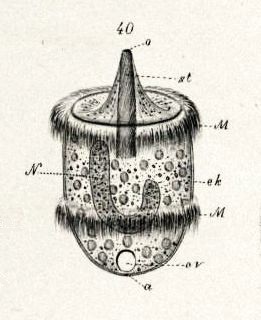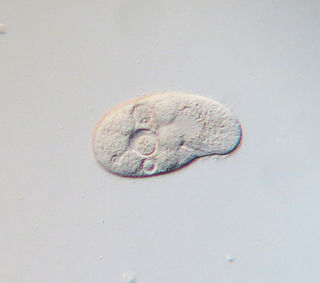| Colpidium | |
|---|---|
 | |
| Colpidium colpoda | |
| Scientific classification | |
| Domain: | Eukaryota |
| Clade: | Diaphoretickes |
| Clade: | SAR |
| Clade: | Alveolata |
| Phylum: | Ciliophora |
| Class: | Oligohymenophorea |
| Order: | Hymenostomatida |
| Family: | Tetrahymenidae |
| Genus: | Colpidium |
| Species | |
| |
| Colpidium | |
|---|---|
 | |
| Colpidium colpoda | |
| Scientific classification | |
| Domain: | Eukaryota |
| Clade: | Diaphoretickes |
| Clade: | SAR |
| Clade: | Alveolata |
| Phylum: | Ciliophora |
| Class: | Oligohymenophorea |
| Order: | Hymenostomatida |
| Family: | Tetrahymenidae |
| Genus: | Colpidium |
| Species | |
| |

Stentor, sometimes called trumpet animalcules, are a genus of filter-feeding, heterotrophic ciliates, representative of the heterotrichs. They are usually horn-shaped, and reach lengths of two millimeters; as such, they are among the largest known extant unicellular organisms. They reproduce asexually through binary fission.

Didinium is a genus of unicellular ciliates with at least ten accepted species. All are free-living carnivores. Most are found in fresh and brackish water, but three marine species are known. Their diet consists largely of Paramecium, although they will also attack and consume other ciliates. Some species, such as D. gargantua, also feeds on non-ciliate protists, including dinoflagellates, cryptomonads, and green algae.
Plagiopyla is a genus of ciliates. It includes nine species:

Colpoda is a genus of ciliates in the class Colpodea, order Colpodida, and family Colpodidae.
Karyorelictea is a class of ciliates in the subphylum Postciliodesmatophora. Most species are members of the microbenthos community, that is, microscopic organisms found in the marine interstitial habitat, though one genus, Loxodes, is found in freshwater.

The ciliates are a group of alveolates characterized by the presence of hair-like organelles called cilia, which are identical in structure to eukaryotic flagella, but are in general shorter and present in much larger numbers, with a different undulating pattern than flagella. Cilia occur in all members of the group and are variously used in swimming, crawling, attachment, feeding, and sensation.

Frontonia is a genus of free-living unicellular ciliate protists, belonging to the order Peniculida. As Peniculids, the Frontonia are closely related to members of the genus Paramecium. However, whereas Paramecia are mainly bacterivores, Frontonia are capable of ingesting large prey such as diatoms, filamentous algae, testate amoebas, and even, in some circumstances, members of their own species. In bacteria-rich saprobic conditions, Frontonia leucas can live as a facultative bacterivore.

Climacostomum is a genus of unicellular ciliates, belonging to the class Heterotrichea.

Dileptus is a genus of unicellular ciliates in the class Litostomatea. Species of Dileptus occur in fresh and salt water, as well as mosses and soils. Most are aggressive predators equipped with long, mobile proboscides lined with toxic extrusomes, with which they stun smaller organisms before consuming them. Thirteen species and subspecies of Dileptus are currently recognized.

Sterkiella histriomuscorum, formerly Oxytricha trifallax, is a ciliate species in the genus Sterkiella, known for its highly fragmented genomes which have been used as a model for ciliate genetics.

Pseudomonilicaryon anser is a species of unicellular ciliates in the family Dileptidae, also known under the names Dileptus anser and Dileptus cygnus. The species is common in fresh water ponds, stagnant pools, mosses and soils.

Colpidium colpoda are free-living ciliates commonly found in many freshwater environments including streams, rivers, lakes and ponds across the world. Colpidium colpoda is also frequently found inhabiting wastewater treatment plants. This species is used as an indicator of water quality and waste treatment plant performance.
Remanella is a genus of karyorelict ciliates, belonging to family Loxodidae. Whereas Remanella inhabits brackish and marine waters, Loxodes – the other loxodid genus – is a freshwater taxon.

Tracheloraphis is a genus of ciliates in the family Trachelocercidae.

Metopus is a genus of anaerobic organisms from the family of Metopidae.

Stentor roeselii is a free-living ciliate species of the genus Stentor, in the class Heterotrichea. It is a common and widespread protozoan, found throughout the world in freshwater ponds, lakes, rivers and ditches.
Parablepharismea is a class of free-living marine and brackish anaerobic ciliates that form a major clade of obligate anaerobes within the SAL group, together with the classes Muranotrichea and Armophorea.

Halteria, sometimes referred to as the jumping oligotrich, is a genus of common planktonic ciliates that are found in many freshwater environments. Halteria are easy to locate due to their abundance and distinctive behaviour with observations of Halteria potentially dating back to the 17th century and the discovery of microorganisms. Over time more has been established about their morphology and behavior, which has led to many changes in terms of classification.

Trachelocercidae is a family of ciliates in the class Karyorelictea.
Holosticha is a genus of littoral ciliates.